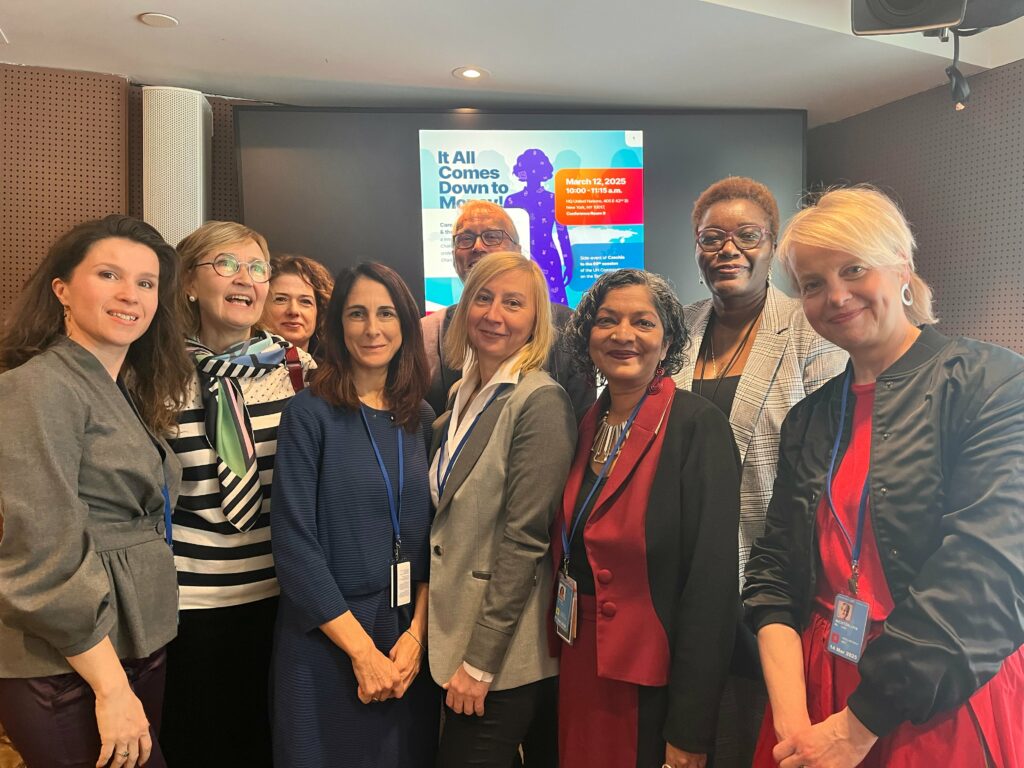At the CSW69 side event, „It All Comes Down to Money! Care, the Value of Work & the Multifaceted Pay Gap,“ hosted by the Czech Government and the Equal Pay Project, experts from international organizations, governments, and academia engaged in a compelling discussion on the persistent gender pay gap (GPG) and the structural barriers reinforcing it.
Czech Republic’s Commitment to Equal Pay
In his opening remarks, Minister Martin Dvořák emphasized Czechia’s commitment to tackling gender-based pay disparities, particularly for women in caregiving roles. He highlighted how Czechia’s Gender Equality Strategy 2021-2030 and the Action Plan for Equal Pay 2023-2026 are actively working to close the GPG through greater pay transparency, career progression opportunities, and addressing occupational segregation.
Additionally, he noted that Czechia is in the process of implementing the European Pay Transparency Directive into national law. To support employers, Czechia is introducing Equal Pay Audits and pay structure analysis tools, ensuring that businesses—especially small and medium-sized enterprises—can identify and address wage disparities. Recognizing that caregiving responsibilities should not fall solely on women, Czechia is also funding initiatives that encourage greater male involvement in caregiving, aiming to break long-standing gender norms.
Gender Pay Gap: A Persistent Challenge
Ms. Emanuela Pozzan (ILO/EPIC) highlighted that the GPG remains one of the most enduring inequalities globally. Despite progress, deep-rooted biases, occupational segregation, and the undervaluation of care work continue to perpetuate disparities. She emphasized that closing the GPG is not just a social justice issue but also an economic necessity. The platform economy, she noted, risks replicating traditional patterns of discrimination, further complicating efforts to achieve pay equity.
The Estonian Perspective: The Highest GPG in the EU
Ms. Marianne Mikko (CEDAW, Estonia) shed light on Estonia’s position as the EU country with the largest GPG. While the post-Soviet transition brought significant change, entrenched gender stereotypes and the concentration of women in lower-paid sectors, particularly outside the lucrative ICT industry, continue to hinder progress. She emphasized CEDAW’s role in defining and enforcing legal standards for gender equality.
The Need for Data & Research
Dr. Jemimah Njuki (UN Women) stressed the importance of accurate data collection in addressing the GPG. Many governments and companies claim they do not have a GPG problem—until they examine their data. She highlighted that lower wages for women often stem from a combination of unpaid labor responsibilities, gendered sectoral concentration, and implicit biases. She called for intersectional analysis and stronger employer accountability, urging stakeholders to join the EPIC initiative to drive change.
She presented findings from UN Women’s groundbreaking research, „Why Women Earn Less,“ which analyzed labor market inequalities in East and Southern Africa. Key insights from the study include:
– The raw gender pay gap in the region is 19% per hour, while the adjusted gap is 8%, meaning women earn 81 cents for every dollar earned by men.
– Pay gaps vary significantly across countries; in Namibia and Mauritius, adjusted gaps exceed raw gaps, while in Mozambique and Tanzania, the gap is statistically insignificant.
– Monthly gender pay gaps are higher than hourly ones due to women engaging in five fewer hours of paid work per week.
– Women with lower education levels face greater income inequalities, with those having only primary education earning 31% less than men.
– Occupational and sectoral segregation contribute significantly to wage disparities, especially in fields where women are overrepresented, such as domestic work, health, and education.
– Gender pay gaps are notably larger in informal employment compared to formal employment.
– Unobservable factors, potentially including discrimination, play a significant role in perpetuating the gender pay gap.
Australia’s Commitment to Structural Reform
Ms. Padma Raman (Australia) shared Australia’s proactive approach to tackling the GPG, emphasizing the need for deliberate, structural interventions. Measures such as accessible childcare, fair parental leave policies, and better remuneration in the care sector have been instrumental. The country’s Workplace Gender Equality Agency publishes firm-level GPG data, driving competition among businesses to improve their gender balance. Transparency has empowered women to choose employers who are committed to pay equity.
Legal and Policy Approaches to Equal Pay
Dr. Barbara Havelkova discussed the evolution of EU equal pay legislation since the 1960s, emphasizing the need for bolder action. She advocated for stronger transparency measures, employer accountability, and institutional mechanisms such as labour inspectorates to enforce compliance. While the new EU Pay Transparency Directive is a step forward, she noted that it remains „extremely soft“ and will benefit less-segregated workplaces more than highly gendered industries.
Moving Forward: Action & Accountability
Throughout the event, speakers underscored that closing the GPG requires multi-faceted solutions, including:
- Stronger legal enforcement and employer accountability.
- Structural economic reforms, including fair wages in undervalued sectors, especially the care sector.
- Investment in data collection to measure and address disparities, including informal labour contributions.
- Education and mentoring programs to encourage women in STEM and high-paying industries
- Advocacy for equal remuneration laws and policies that ensure non-discrimination in hiring and promotion.
- Promotion of work-life balance through investment in social services, infrastructure, and support for unpaid care work.
- Challenge discriminatory norms and encourage women’s access to high-paying fields.
The key message? Change is possible—but only with commitment, transparency, and collective action.
